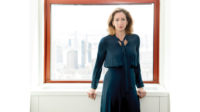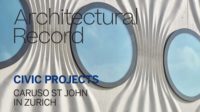The 38-year-old Dutchman Anne Holtrop talks about his work with an artist’s sensibility, extracting form from existing, or completely random, conditions. He counts among his influences more artists than architects, and his first works were temporary structures, each within a museum context. That blurred line between art and architecture is one that Holtrop has been straddling his entire life.
As a child, Holtrop dreamed of going to art school, but his father encouraged him to pursue architecture instead. After completing four years at a technical school—where he “learned to construct things and calculate structures,” he says—he enrolled in the Academy of Architecture in Amsterdam. Though well-known in the Netherlands, the school doesn’t have quite the international reputation of the nearby Berlage Institute. “It was a very Dutch environment,” Holtrop recalls. Tutors included OMA partner Reinier de Graaf and the leader of the Dutch structuralist movement, Herman Hertzberger. Yet today, according to Holtrop, people are surprised to learn he is from the Netherlands when they see his architecture. “This makes me happy, because my work is a very personal investigation.”
During his studies, Holtrop worked at several Dutch firms, including Claus en Kaan Architecten, and completed a research project with de Graaf. But upon graduation, he took a job as an assistant to artist Krijn de Koning. Influenced by an earlier generation of conceptual artists like Christo and Jeanne-Claude and Daniel Buren, whose large-scale pieces interact with the landscape or built environment, de Koning makes site-specific works that are part architecture and part sculpture.
“For me, the work of those artists is very architectural with respect to size and location,” Holtrop says. But unlike architects, they don’t necessarily begin projects in response to a commission. “That helped me to start my own practice, convincing me to take a more autonomous position rather than waiting for an assignment from a client.”
Holtrop relied on grant money instead of the resources of a client to build his first architectural projects. The Trail House and the Temporary Museum were sinuous plywood structures, the form of the first inspired by the existing contours of the landscape, the latter derived from inkblot drawings. “Those were spatial investigations, and the material was not important at all,” admits Holtrop. “Plywood is a cheap material that made it possible to build all those curves.”
Those early temporary works gave way to substantial projects for Holtrop’s small but global practice, including the competition-winning Museum Fort Vechten in Bunnik, the Netherlands, and the Bahrain Pavilion for the Milan Expo 2015—each one, says the architect, an “appropriation of form.” According to Holtrop, the design for these concrete structures did not change at all from the initial concept. “What I proposed in the museum competition, we completely made, with no concession,” he says. “I’m sure I could not have done these buildings in this way if I had not done the other works.”
The Bahrain Pavilion, which is being transported to Bahrain itself as a permanent museum and botanical garden, has led to other projects in the small Middle Eastern nation, where Holtrop now lives with his wife. With offices in both Amsterdam and Bahrain, he continues to approach his work—including a residential project in Spain—as an artist. “What I’m interested in is how architecture can appear, not from a problem-solving perspective but my own point of view.”
Studio Anne Holtrop
FOUNDED: 2009
DESIGN STAFF: 6 (3 in Amsterdam; 3 in Muharraq, Bahrain)
PRINCIPAL: Anne Holtrop
EDUCATION: HTS Utrecht, B.S. Building Engineering, 1999; Academy for Architecture, Amsterdam, M.Arch. 2005
WORK HISTORY: Krijn de Koning, 2005–09
KEY COMPLETED PROJECTS: Museum Fort Vechten, Bunnik, the Netherlands; National Pavilion of the Kingdom of Bahrain, Expo Milan, 2015; Batara, Wageningen University, Wageningen, the Netherlands, 2013; Temporary Museum, Heemskerk, the Netherlands, 2010; Trail House, Museum De Paviljoens, Almere, the Netherlands, 2009
KEY CURRENT PROJECTS: Relocation of the National Pavilion of Bahrain, Muharraq, Bahrain, 2016; Qaysariya Suq, Muharraq, 2016; Conversion of the former king’s house to a museum, Muharraq, 2016













Post a comment to this article
Report Abusive Comment